Easy to care for and ideal for pickling, the “French Bunch” tomato: review of the variety and nuances of care
Beginning gardeners often face a number of difficulties when growing tomatoes. After all, this culture needs regular care. To get a bountiful harvest, tomato bushes need to be regularly pruned, treated with various drugs against diseases and protected from cold weather by planting them in greenhouse structures.
Knowing about all the problems of cultivating tomatoes in our country, breeders are developing new varieties that are resistant to bad weather and tomato diseases. These include the French bunch tomato. It not only withstands negative environmental factors, but also does not need stepsoning. Read on to learn how to grow this tomato variety and get maximum yield.
Description of the variety
French grape tomato is a variety that, despite its name, is in no way connected with France. It was bred in Russia by Siberian breeders.
This variety is not yet in the register. It is produced by the Siberian Garden company. The tomato has gained popularity among gardeners due to its productivity and low maintenance requirements.
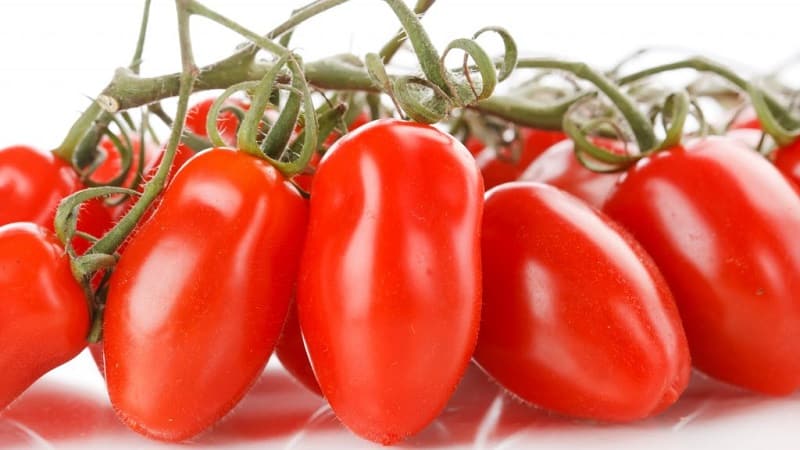
Distinctive features
The French bunch tomato is easy to grow. During its growth, it forms a minimal number of stepsons. Thanks to this, the bush does not need to be formed. This is an undoubted advantage, because novice gardeners consider pinching to be the main disadvantage of caring for tomatoes.
The fruits of this variety are oblong. They are red inside and outside. They contain a lot of dry matter, so most gardeners consider them not juicy enough. The berries have the usual taste for tomatoes - sweet and sour.
French bunch is ideal for canning. In brine, fleshy tomatoes retain their shape. They are also suitable for freezing in pieces. Due to their lack of juiciness, not everyone likes them fresh.
French grape has immunity to all tomato diseases. This variety rarely affects even late blight, which often causes late blight in late-ripening tomatoes.
Main characteristics
French grape will delight both beginners and experienced gardeners. This tomato has high yields and is undemanding in care.

Characteristics:
| Parameter | Indicators |
| Bush type | Determinant. Not standard. When grown in open ground, it grows up to 1 m. When grown in a greenhouse, it reaches 1.5-1.7 m. The bush is not spreading. Forms a minimum number of stepsons. The stems are thick and strong. The leaves are medium-sized, dark green, without pubescence, reminiscent of potatoes. The inflorescences are simple. The first is formed at the level of 7-9 leaves, the next after 1 leaf. The fruits are produced in clusters. There are 10 to 15 tomatoes on one bunch. |
| Growing method | Suitable for growing in open ground and in greenhouses. In the northern regions, the second method is mainly used. |
| Productivity | High. More than 10 kg of fruits are harvested from 1 bush per season. For 1 sq. m plant 3-4 plants. |
| Fruit | Medium size. One berry weighs from 70 to 100 g. The fruits are red-orange or bright red on the outside and red on the inside. A light spot may be present at the base and in the middle of the pulp.Inside each tomato there are 2 chambers with seeds. The shape of tomatoes is elongated, sometimes pear-shaped. There is no pronounced ribbing at the base. The taste is sweet and sour. The fruits are fleshy, not very juicy. |
| Transportability | High. Tomatoes have a tough skin that protects them from damage during transportation. The fruits of this variety can be stored for more than a month. |
| Ripening time | Mid-late variety. The berries will ripen 115-120 days after sowing the seeds. Fruiting continues until the first frost. |
| Disease resistance | Immunity is high. Tomato is resistant to the main diseases characteristic of nightshade crops. |
Growing seedlings
Tomato seedlings begin to be grown 55-65 days before planting in open ground. The timing of sowing seeds depends on the climatic characteristics of the region.:
- southern cities - end of February;
- central Russia - mid-March;
- northern regions – early April.
Seed treatment
Pre-treatment of seeds will protect seedlings from infections, temperature changes and other negative factors. This will also speed up the germination of planting material.
Before buying seeds you need to check their expiration dates. Expired seeds will not germinate.
To check the germination of seeds, they are soaked in a solution prepared from a teaspoon of salt and a glass of water. After half an hour, the seeds that float to the surface are collected and thrown away. Those specimens that sank to the bottom are considered suitable for planting.
 To prevent infection of seedlings blackleg and other diseases, the seeds are disinfected. There are several ways to do this:
To prevent infection of seedlings blackleg and other diseases, the seeds are disinfected. There are several ways to do this:
- Potassium permanganate solution. Take 2 mg of potassium permanganate per 200 ml of water. The seeds are soaked for half an hour. After this, they are washed with clean water and dried.
- Hydrogen peroxide. Planting material is soaked in the product for a quarter of an hour. The seeds are washed under running water and dried.
- Soda solution. For 100 ml of water take 0.5 tsp of salt. The seeds are soaked in the product for 10 hours. The drug not only disinfects planting material, but also stimulates its germination.
To make the seeds germinate faster and have acquired resistance to negative environmental factors, they need to be stimulated.
Methods for stimulating germination of planting material:
- Treatment with special purchased preparations. Most often they use “Epin” or “Sodium Humate”.
- Using homemade remedies. Suitable preparations include aloe juice, honey water, and soda solution.
- Cold treatment. Before planting, seeds are placed in the refrigerator for 2-3 days.
Options for soil and containers for tomato seedlings
Tomato seedlings need light and nutritious soil. You can buy it in a specialized store or prepare it yourself.
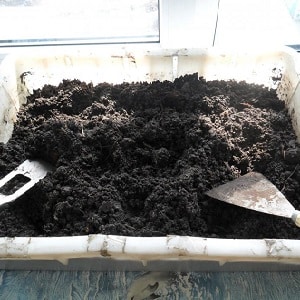 There are several options for soil mixtures for tomatoes:
There are several options for soil mixtures for tomatoes:
- Peat, humus and turf mixed in equal proportions. To 10 liters of the resulting mixture add 1 tbsp. water.
- 10 kg of peat mixed with 1 glass of ash. 10 g of potassium fertilizer and urea, 30 g of superphosphate are added to the composition.
- Black soil and sand mixed in equal proportions. To enrich the composition, potassium fertilizers and superphosphate are used.
Large containers are used for sowing seeds.. Plastic trays, wooden boxes, trimmed 6-liter bottles, etc. will do. Tomatoes are planted in individual pots with a volume of 300-500 ml. Plastic cups are also used. Holes are made in homemade containers.
Sowing seeds
French bunch tomato seeds are sown in the usual way.. This variety tolerates picking well.Furrows 1 cm deep are made in the soil at a distance of 2 cm arcs from each other. The seeds are placed in them at a distance of 1.5 cm.
The planting material is covered with earth on top. The soil is moistened using a spray bottle with warm water. The containers with seeds are covered with film and placed in a place with a temperature of at least 23 degrees. The seeds will germinate in 3-7 days.
Other varieties of tomatoes:
Full review of the Black Heart of Breda tomato
Seedling care
Growing seedlings yourself is not difficult. For this you need to follow a few important rules:
- After the seeds germinate, it will not be possible to moisten the soil from a spray bottle. When watering tomato seedlings, you need to make sure that water does not get on the greens. Use only settled liquid at room temperature.
- After the first shoots appear It is recommended to place the seedlings for a week in a well-lit place with a temperature of 15 degrees. Then the plants are returned to heat. This will prevent the tomatoes from stretching.
- Seedlings need 16 hours of daylight. In spring, natural light will not be enough for tomatoes. This is compensated by using fluorescent lamps.
- Plants are planted in individual pots after the appearance of the first two true leaves. A layer of broken brick, glass, expanded clay or shell rock is poured onto the bottom of the pots for aeration.
- 2 weeks after the pick plants are fed for the first time. Use a growth stimulator or vermicompost. Fertilizers are applied a second time after another 14 days. 3 days before picking tomatoes to a permanent place, they are fed for the last time. For this purpose, compositions with potassium and phosphorus are used.
- 10 days before transplanting seedlings to a permanent place they begin to harden her.Plants are taken outside. First for half an hour, then for 1 hour, etc. The time is gradually increased to 12-16 hours.

Agricultural technology
You need to plant the French bunch tomato in a permanent place when the soil warms up., and the seedlings will get stronger. The further south the region, the earlier the tomatoes reach their permanent location. Typically, planting in open ground is done in May, and in a greenhouse in April.
Landing in a permanent place
Tomato beds are prepared in the fall. They are dug up and cleared of cultivated plants and weeds. To enrich the soil, humus is scattered over it. If the acidity of the soil is high, then it is mixed with dry lime. In the spring, the area of the garden chosen for growing tomatoes is dug up again. It is fertilized with chicken droppings. Then the soil is disinfected by watering it with a solution of copper sulfate.
Holes for tomatoes are dug in rows in a checkerboard pattern.. For 1 sq. m you need to plant no more than 4 plants. Otherwise, productivity will decrease.
On a note. 3 days before planting tomatoes in a permanent place, they are watered and fed. This will help them quickly settle into their new place and make it easier to remove them from the pot.
Plants are placed in holes along with a lump of earth. The root is formed towards the center. Plants are buried down to the first leaves. The holes are covered with earth, compacting it.
Each tomato is watered with a liter of water.. Next time the soil is moistened after 2 weeks.
Tomato care
French bunch tomato bushes do not need to be formedHowever, experienced gardeners still recommend removing yellowed and lower leaves.
Tomatoes of this variety need to be tied up. Otherwise, the stems will simply break under the weight of the fruit.
Reference. For tying, use synthetic thread, since the natural material will begin to rot.
Watering should be plentiful, but not frequent. In hot summers, moisten the soil once every 2 days. Use warm, settled water. The liquid should not get on the above-ground parts of the plants.
Feed tomatoes every 2 weeks. Use mineral and organic fertilizers. You can buy them in stores or prepare them yourself.
Twice during the growing period For tomatoes, foliar feeding is applied using fertilizers that contain boron.
Tips for choosing fertilizers
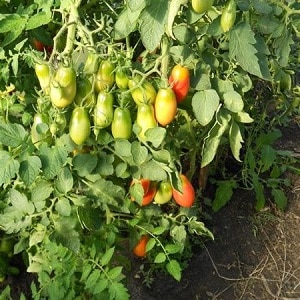 Fertilizers for tomatoes do not need to be purchased at the store. Experienced gardeners often prepare them themselves. There are several popular recipes for feeding tomatoes:
Fertilizers for tomatoes do not need to be purchased at the store. Experienced gardeners often prepare them themselves. There are several popular recipes for feeding tomatoes:
- Fertilizing with yeast. For a 10 liter bucket of water take 0.5 kg of chicken manure, 10 g of yeast, 5 tbsp. l. sugar and 0.5 kg of ash. The mixture is infused for 24 hours. 1 liter of the mixture is diluted in 10 liters of water. Each plant is watered with 2 liters of this fertilizer.
- Fertilizer with chicken manure. Chicken manure is diluted with water in a ratio of 1:10. The mixture is infused for 3 days. Then 15 g of ammonium nitrate is added to it. Take 1 tbsp per plant. such a composition.
- Feeding with mullein. For 10 liters of water take about.5 kg of mullein. Add 0.5 tsp to the resulting composition. boric acid, 1 tbsp. l. nitrophoska and 2 tablets of microfertilizers. For 1 plant take 1 liter of this composition.
Diseases and pests
The French grape tomato has high immunity to most tomato diseases. It does not even suffer from late blight, which is typical of late-ripening nightshade crops. Even good immunity to tomato diseases is not a 100% guarantee that the plant will not get sick.
It is important to follow the rules of prevention:
- All tools, containers and soil, with which the plants will interact, are disinfected. This also applies to seeds.
- Watering rules must be followed. It is important not to over-moisten or over-dry the soil. The liquid should not come into contact with the greenery of the plants.
- For prevention several times a season tomatoes are sprayed with a solution of potassium permanganate, copper sulfate or Fitosporin.
- To protect plants from bugs, they are treated with a soap solution and dandelion decoction. All beetles that appear on the bushes are collected by hand.
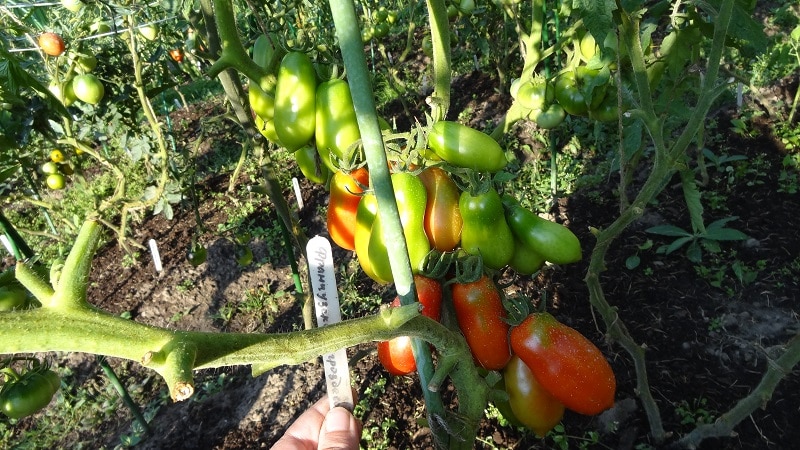
The nuances of cultivating tomatoes in open and closed ground
The greenhouse needs to maintain optimal humidity. To do this, the room is regularly ventilated. This procedure helps reduce the likelihood of plant disease. In protected ground, French bunchweed sometimes begins to branch heavily. If this happens, then the extra stepsons will have to be removed.
Outdoors young tomatoes face night frosts. To protect them, the beds are covered with film in the evening for the first 2 weeks after picking the seedlings.
It is necessary to mulch the beds of tomatoes growing in unprotected soil.. The soil is covered with humus, straw or hay. These materials protect plant roots from cold, diseases and pests. They also provide additional fertilizer.
Harvesting and application
The first fruits of the French bunch ripen in August. They are collected individually, as they do not ripen evenly on the bunches.
On cloudy days and frosts, it is recommended to collect unripe tomatoes.. They will ripen at home in a warm place.
The fruits of the French bunch can be stored for several months.. This variety is suitable for pickling and canning.
Advantages and disadvantages
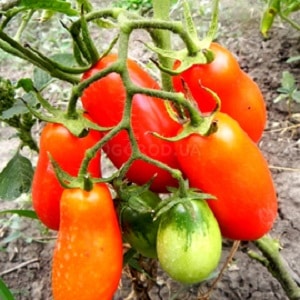 Benefits of French grape:
Benefits of French grape:
- possibility of growing in protected and open ground;
- high productivity;
- high transportability;
- no need for stepsoning;
- high immunity to tomato diseases;
- low maintenance requirements.
Disadvantages of the variety:
- late ripening;
- insufficient fruit juiciness.
Read also:
Features of growing the tomato hybrid "Tornado"
A variety with impeccable taste and aroma - the “King of London” tomato
Farmer reviews
Reviews of the French bunch tomato are mostly positive. However, some farmers do not like that the fruits of this productive variety are not juicy enough.
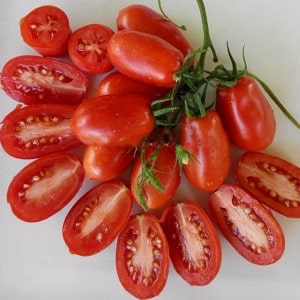 Irina Ignatieva, Moscow: “I’ve been planting French grape for three years now. The most unpretentious variety from my collection. It does not need to be planted; it is also not demanding when it comes to watering. The fruits are really dry, but I consider this a plus, since tomatoes don’t leak in salads.”.
Irina Ignatieva, Moscow: “I’ve been planting French grape for three years now. The most unpretentious variety from my collection. It does not need to be planted; it is also not demanding when it comes to watering. The fruits are really dry, but I consider this a plus, since tomatoes don’t leak in salads.”.
Ilya Vasiliev, Voronezh: “I didn’t really like the French grape tomato. Its fruits are dry and suitable only for pickling. It's really easy to grow. From 1 sq. m collected 4 buckets of tomatoes. Just like in the photo, all the brushes were literally strewn with fruits.”.
Conclusion
The French bunch variety is an excellent option for gardeners who want to get a rich harvest of tomatoes with a minimum of effort.
This tomato does not require pinching and is able to tolerate unfavorable environmental factors. Therefore, even summer residents who do not have a greenhouse can cope with its cultivation.